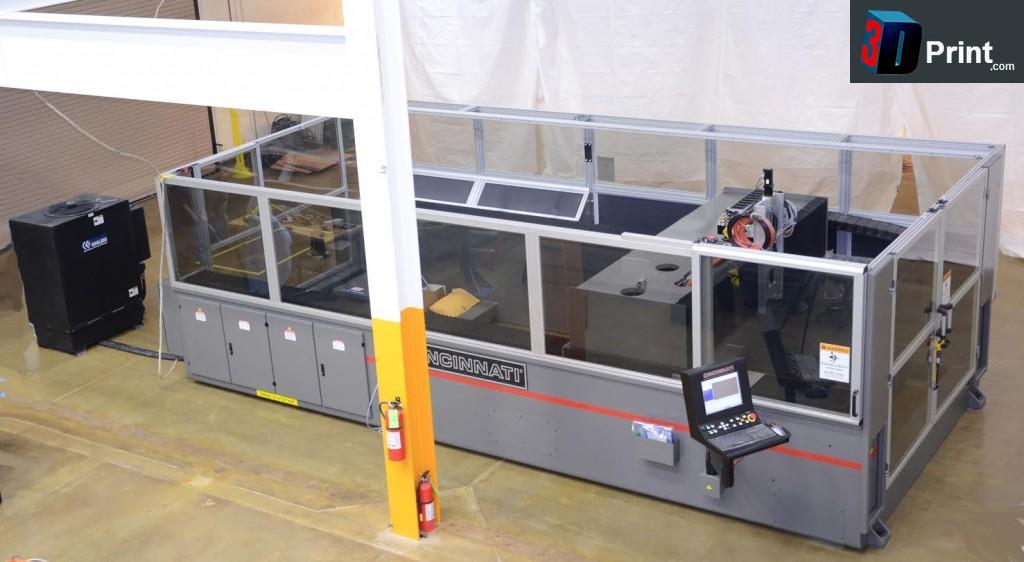Back in February the U.S. Department of Energy’s Oak Ridge National Laboratory (ORNL), and Cincinnati Inc. set quite a goal for themselves within the 3D printing space. They set out to create a 3D printer which would be capable of printing at speeds of over 200 times that of traditional printers on the market at that time. If the magnitude of such a seemingly far fetched goal did not impress you, then the fact that they also wanted to make this machine 10 times larger than most of the other printers out there, could have.
In the months since ORNL and Cincinnati Inc. launched their initiative, the initial buzz pertaining to what they were working on, died down, but hasn’t been forgotten. Such a machine, if possible, would surely send shivers down the spines of traditional manufacturers, who could be left with the option to adopt such technology or lose a bulk of their business to those who do.
Because of my extreme curiosity of this matter, I decided to reach out to Rick Neff, manager of market development, for Cincinnati Inc., to see what kind of progress they have been making, and to get some more information on this project. Neff explained the technology behind Cincinnati Inc.’s big area additive manufacturing (BAAM) machine:
“BAAM is a FDM machine on steroids. We use feed stock of plastic pellets like [those] used in an injection molding machine, so it is affordable for large production parts. At over 10 pounds per hour of ABS plastic it is several orders of magnitude faster than other typical FDM systems. We sacrifice some accuracy and detail for speed.”
 When I asked Neff about their goal of creating a printer capable of printing at speeds 200 times that of traditional machines, to my surprise, he informed me that the prototype gantry of their BAAM machine is already capable of such a task. The company is also working on ways to create smooth finishes on objects, since the resolution of the actual prints are lacking some quality, due to the large size of the print nozzle (0.3 inches). Neff was also kind enough to provide us with an image (left) showing a 3D printed table and chairs, that were on display at RAPID 2014 last week. He said that each chair took approximates 150 minutes to print on their BAAM machine.
When I asked Neff about their goal of creating a printer capable of printing at speeds 200 times that of traditional machines, to my surprise, he informed me that the prototype gantry of their BAAM machine is already capable of such a task. The company is also working on ways to create smooth finishes on objects, since the resolution of the actual prints are lacking some quality, due to the large size of the print nozzle (0.3 inches). Neff was also kind enough to provide us with an image (left) showing a 3D printed table and chairs, that were on display at RAPID 2014 last week. He said that each chair took approximates 150 minutes to print on their BAAM machine.
There is still a lot of work to be done on this project, but if you are like us, you will likely be quite surprised at the progress which has been made. They expect to begin taking orders for production machines around the end of the year, but according to Neff, they are not ready to publicize a price point for their BAAM machines.
Whether this type of 3D printer takes off or not, is yet to be seen. Neff himself understands that there are still some question marks around this type of technology, stating:
“We are not sure if there is a market for a machine this big. It is very different from anything in the industry. Not sure where it will be in 5 years. We have the capability of building just a few machines annually or many machines, depending on what the market needs.”
Clearly, such a machine could be a game changer, not only within the large scale 3D printer space, but also within the entire manufacturing industry as a whole. The ability of Cincinnatti Inc. to improve upon this already seemingly amazing technology, and provide it at a market friendly price, will determine just how far these machines go. Below you will find a picture of the latest BAAM 3D printer. As you can see, it is enormous. Let us know what you think about these revelations, and what they could mean for the manufacturing industry in the long run. Discuss it with our community in the BAAM 3D Printer forum thread at 3DPB.com.
Subscribe to Our Email Newsletter
Stay up-to-date on all the latest news from the 3D printing industry and receive information and offers from third party vendors.
You May Also Like
Gorilla Sports GE’s First 3D Printed Titanium Cast
How do you help a gorilla with a broken arm? Sounds like the start of a bad joke a zookeeper might tell, but it’s an actual dilemma recently faced by...
Nylon 3D Printed Parts Made More Functional with Coatings & Colors
Parts 3D printed from polyamide (PA, Nylon) 12 using powder bed fusion (PBF) are a mainstay in the additive manufacturing (AM) industry. While post-finishing processes have improved the porosity of...
$25M to Back Sintavia’s Largest Expansion of Metal 3D Printing Capacity Since 2019
Sintavia, the digital manufacturing company specializing in mission-critical parts for strategic sectors, announced a $25 million investment to increase its production capacity, the largest expansion to its operations since 2019....
Velo3D Initiates Public Offering in a Bid to Strengthen Financial Foundations and Drive Future Growth
Velo3D (NYSE: VLD) has been among a number of publicly traded 3D printing firms that have attempted to weather the current macroeconomic climate. After posting a challenging financial report for 2023,...

































